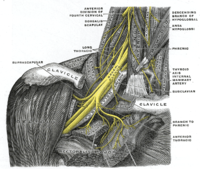
Photo from wikipedia
Arthrogryposis multiplex congenita (AMC) and obstetrical brachial plexus palsy (OBPP) are motor disorders with similar symptoms (contractures and the disturbance of upper limb function). Both conditions present as flaccid paresis… Click to show full abstract
Arthrogryposis multiplex congenita (AMC) and obstetrical brachial plexus palsy (OBPP) are motor disorders with similar symptoms (contractures and the disturbance of upper limb function). Both conditions present as flaccid paresis but differ from each other in the pathogenesis: AMC is a congenital condition, while OBPP results from trauma during childbirth. Despite this difference, these diseases are identical in terms of their manifestations and treatment programmes. We compared the cognitive skills of children with AMC and OBPP diagnoses with those of healthy children; we also compared the motor skills of impaired children with those of healthy ones. The patients in both groups significantly differed from the healthy children with regard to psychological parameters, such as ‘visual memory capacity’ and ‘thinking’. Moreover, the two groups with children with AMC and OBPP significantly differed from each other in motor skill parameters, such as ‘delayed motor development’, ‘general motor development’, and the ‘level of paresis’. Upper limb motor function in the OBPP children was less impaired compared to that of the AMC children. However, we did not find any significant differences in cognitive deficits between the AMC children and the OBPP children. This may indicate that motor impairment is more significant than the underlying cause for the development of cognitive impairment; however, the factors causing this phenomenon require further study (e.g., social environment, treatment, and rehabilitation programme).
Journal Title: International Journal of Environmental Research and Public Health
Year Published: 2023
Link to full text (if available)
Share on Social Media: Sign Up to like & get
recommendations!